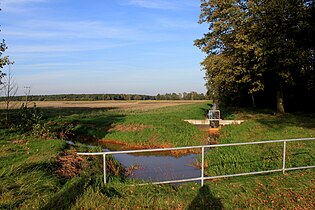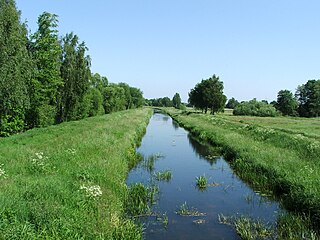Kleine Röder (Black Magpie)
|
Kleine Röder Schwarzgraben |
||
|
The confluence of the Kleine Röder and the Schwarze Elster |
||
| Data | ||
| Water code | DE : 53852 | |
| location | Saxony and Brandenburg , Germany | |
| River system | Elbe | |
| Drain over | Black Elster → Elbe → North Sea | |
| origin | Junction from the Großer Röder at Zabeltitz 51 ° 20 ′ 44 ″ N , 13 ° 29 ′ 32 ″ E |
|
| Source height | 107 m above sea level NN | |
| muzzle | near Zobersdorf in the Black Elster Coordinates: 51 ° 30 '23 " N , 13 ° 24' 49" E 51 ° 30 '23 " N , 13 ° 24' 49" E |
|
| Mouth height | 86 m above sea level NN | |
| Height difference | 21 m | |
| Bottom slope | 0.53 ‰ | |
| length | 40 km | |
| Small towns | Grossenhain , Gröditz , Bad Liebenwerda | |
| Communities | Röderaue , Tiefenau | |
The Kleine Röder , also known as the Schwarzgraben, is an approximately 40-kilometer-long left tributary of the Große Röder in Saxony and Brandenburg , which flows into the Schwarze Elster from the left .
course
From Zabeltitz to Kröbeln
The Kleine Röder branches off from the Großer Röder at Zabeltitz and runs in a north-westerly direction. In its course, the Kleine Röder with the Koselitzern , Tiefenauern and Kröbelner ponds feeds several artificial bodies of water specially created for fish farming. In addition, the Kleine Röder once took over the apex posture of the Elsterwerda-Grödel raft canal , as it has the highest water level of the three estuary arms of the Großer Röder used to feed this historic waterway.
The Ziegram
Behind the town of Kröbeln, which belongs to Bad Liebenwerda, the river reaches the Ziegram , a swamp and moorland area of around 1000 hectares. The Kleine Röder flowed through this landscape in earlier times as Schwarzgraben with numerous rivers and also touched the neighboring localities, which meant that some of the inhabitants could drive directly into the area by barge. This is particularly evident in the town of Kosilenzien, where there is said to have been a Kahngasse in the east of the town until the present . A regulation of the course of the river and extensive improvement measures did not take place until the 1920s with the use of prisoners and in the 1930s by the Reich Labor Service . Here, too, fish ponds were once created after the river regulations, but these were soon abandoned and leveled due to their inefficiency.
With its open wet meadow areas and reed-covered areas, the Ziegram forms an important breeding area for the native bird world and is used by migratory birds in spring and autumn as a resting and gathering place. Between 1984 and 1994 members of the Biological Working Group were able to detect 107 bird species, 80 of which were regular or isolated breeding birds. Among other things, gray herons , teal ducks , cranes , white-tailed eagles , golden hammer , red kite and marsh warbler have been observed here .
From Oschitty to the mouth
To the northeast of the Ziegram, the Kleine Röder turns towards the village of Oschätze . Shortly before the Brandenburg spa town of Bad Liebenwerda , it finally flows into the Schwarze Elster near the districts of Zobersdorf and Zeischa .
Web links
Notes and individual references
- ↑ Heimatverein Elsterwerda und Umgebung e. V./Heimatverein for research into the Saxon steelworks-Gröditzer Stahlwerke GmbH (ed.): 250 years of the Grödel-Elsterwerda raft canal 1748-1998 , Lampertswalde 1997
- ↑ a b c Günther Peschel: Hike to the Ziegram . In: Home calendar for the Bad Liebenwerda district . 1996, p. 192-195 .
- ^ Günther Peschel: Rural way of life, lust and joy in the Ziegramdörfern . In: Home calendar for the Bad Liebenwerda district . 2001, p. 184-195 .
- ↑ Ralph Ulrich: Breeding and resting birds of the Ziegrams . In: Home calendar for the Bad Liebenwerda district . 1996, p. 196-198 .




